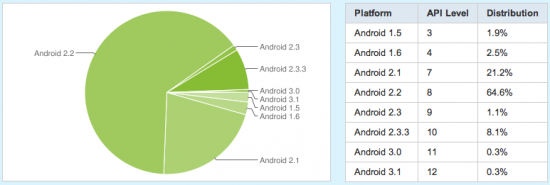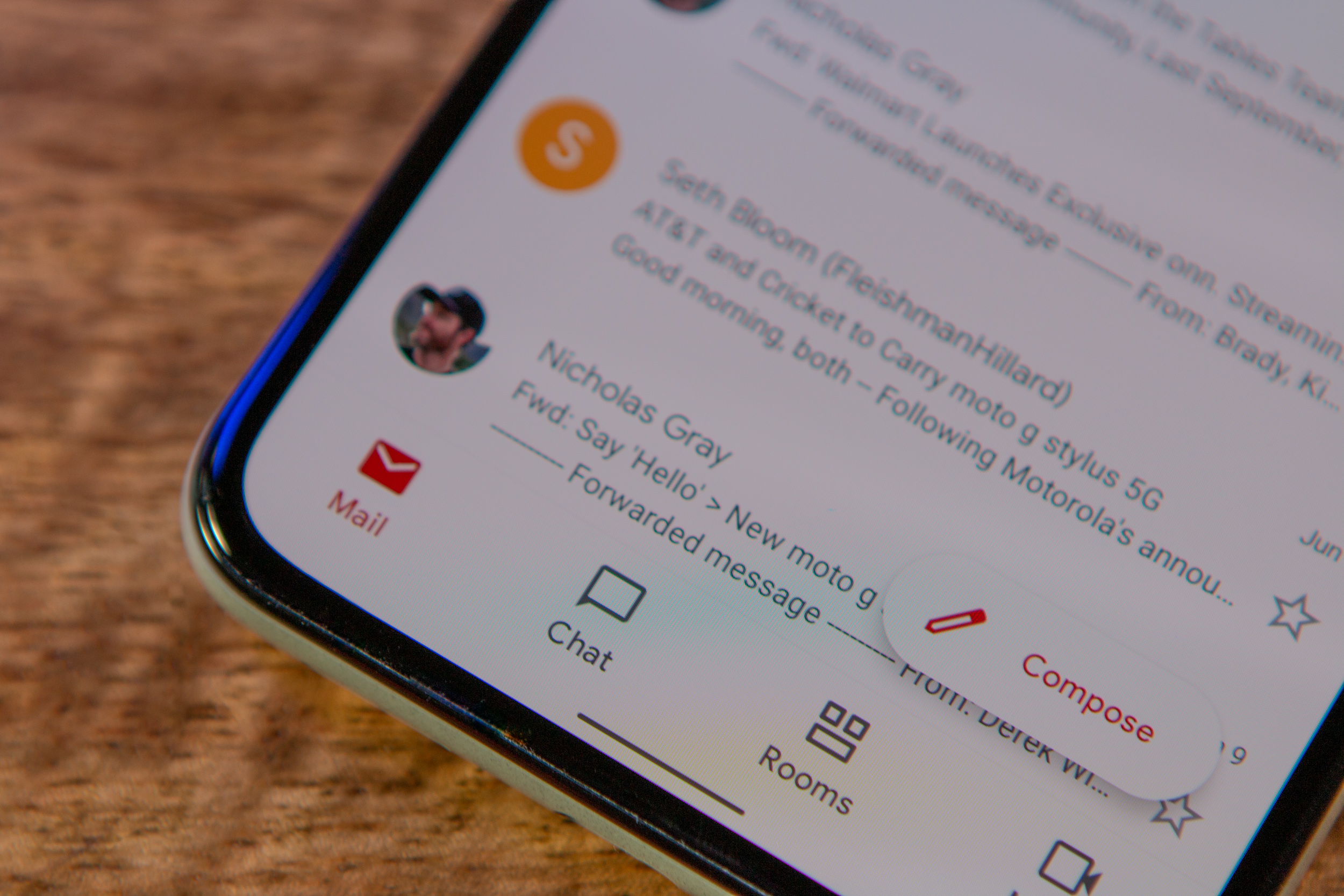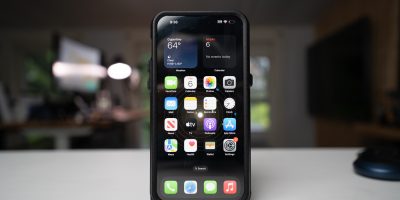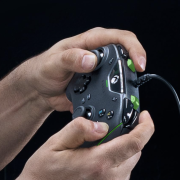It seems like forever ago since we got one of these. Google’s released a new platform versions chart chart for the two weeks ending June 1st. At first glance, Honeycomb still hasn’t broken much ground. Android 3.0 and 3.1 make up for a combined .6%, even after Google gave all of those tablets away at I/O a few weeks ago. We hope for that to change drastically with competitively-priced tablets from ASUS, Acer and Samsung being heavily produced starting this month and more to come from other manufacturers soon.
Last time we saw Gingerbread, it was sitting at a combined 4%, but it’s clawing and scratching its way near the top as it now accounts for 9.2% of all devices. This is most likely due to the successful launch of the Samsung Galaxy S and Sony Ericsson’s Xperia PLAY and Arc, and with more older phones getting upgrades to Gingerbread this summer, we should see it with double digits in no time. (Is 20% before the end of the summer asking too much?)
Eclair and Froyo are still dominating with a combined 85.8%, but Froyo thankfully has a majority of that at 64.6%. It seems like it was just yesterday we were talking about how Android 1.5 and 1.6 were still dominating the charts while Android 2.1 was struggling to break ground, and now those latter two are just about extinct. We couldn’t be happier about that. (Don’t get me wrong, though – I do still love green-frosted cupcakes and donuts.) [Android Developers]











I’m sure this chart will look quite different in another quarter…Gingerbread is rolling out & summer releases should add some flavor to Honeycomb (hopefully)
Of course Honeycomb is struggling to take off. We are just getting to Honeycomb tablets that start to capture all of what an Android Tablet should be.
Even still though I don’t see a tablet that has it all.
Samsung 10.1 great body but limited I/O, no SD
Toshiba Thrive, Great I/O, but too hefty for the times.
Agreed, I think the shortages of decent tablets has had a huge effect. I just got my tablet after waiting over a month. It’s also still got a very beta feel and the tablet will crash and restart periodically.
Agreed! I’m dying to get a tablet but there is nothing to pick from.
Xoom – half the stuff doesn’t even work. SDslot, 4G missing, $$$
gSlate – tied to T-Mobile and $$$
Transformer – No data, can’t find one
Samsung – No SDslot, No USB, No HDMI, (without proprietary connections),
Toshiba – We’ll just have to see. Not looking very promising.
So, my question is… Why would we buy a tablet at this point.
Don’t get me wrong, I want one but there isn’t anything to pick from. Make one to compete and I’ll be all over it.
Curse the Motorola i1 holding the chart back.
FRAGMENTATION!!!!!!111oneone
I kinda miss Android 1.0 on my G1 :P
Whats the difference between 2.3 and 2.3.3?
.3
glitches were fixed and i believe minor things were added.
IN regards to the Nexus S its the color change other than that nothing.
Mainly bug fixes and minor changes
Fragmentation is a part of life. You can’t expect system software written for cpu’s, displays, and apps of 2011 is still going to be backward compatible with devices built for the operating systems of 2009. Technology is moving too quickly for that to happen.
I do think that Google would be wise to require manufacturers to limit carrier customization, standardize hardware requirements, and mandate update time lines to improve the update lag. The bit hoopla over the gingerbread release seems silly now. It was months before anyone but developers got to look at it. Now Honeycomb for tablets and a new version is on the horizon and who knows when last year’s flagship devices will event see 2.3
As long as all apps work fragmentation means nothing. Different OS versions has had no impact on the apps I can run.
Exclusive games for the Xperia Play and Tegra 2 are a bigger issue and is the area that needs the most focus.
Carrier and OEM customizations have had zero impact on app compatibility and is therefor not an issue worth fixing.
I’m surprised by the huge amount of people still running 2.1 I would have thought everyone was caught up on froyo by now
most of them have already rooted like my bro
Android 2.3.4 is not listed and yet most of CyanogenMod is running it. Are these stats just for Android devices running the Stock image?
2.3.4 is pure bug-fixing, no new API. So it shares the same API level (10) as 2.3.3. Google’s data is really distribution by API level, which they map to Android version number. So, in short, the number for 2.3.3 (8.1%) includes devices running 2.3.4, as well.
I am wondering how rooted users with custom roms are handled in graphs like this.
I’m pretty sure they’re not.
they’re put in like everyone else…
A lot of the GB 2.3.3 installs are coming from CM7. It has over 330,000 active users, plus maybe 150,000 more that choose not to register. If not for CM, what other phones are running 2.3.3? Nexii? A couple HTC’s? XPeria phones? CM is dominating this segment http://stats.cyanogenmod.com/
@e1d529face3521b569f705c9ea1124fe:disqus A lot of the GB 2.3.3 installs are coming from CM7.
Dude, seriously… 8.1% of *all* Android phones is far, far in excess of your paltry 330K figure. :) Think 25 times that, or more.
@e1d529face3521b569f705c9ea1124fe:disqus If not for CM, what other phones are running 2.3.3?
Pre-release ROMs (and some finals) started appearing last year. To my knowledge, we’ve seen semi-official releases applicable to — in one form or another — Desire HD, G2, Incredible S, MyTouch 4G, Nexus One, Nexus S, Galaxy S, and (orig.) Droid units. Droid X and Droid 2 ROMs appeared last week; DX alone should be a couple million units.
Again, that’s just all of the (reputedly) official Gingerbread ROMs whether released via official channels or more dubious outlets. But there’s also a long list of admittedly home-grown GB ROMs that are floating around in developer circles. Here’s an archival page on the XDA ‘site, tho’ I can’t say if it’s necessarily complete.: http://goo.gl/xwvcN
Lastly, just FYI, another five or six official Gingerbread ROMs are scheduled to arrive in the next few weeks. So it’s a good bet the GB 2.3.3 ranks could double by month’s end. I bet they’ll account for 30%-35% of the total before Sept.
Seems like honeycomb is doing ok to me. The few honeycomb tablets that are out now are able to hold their own percentage vs the many android phones that are being activated daily. I’m sure in the field of tablets their percentage is rising quickly.
Curse the Cliq XT for holding the chart back on 1.5. Lol
Whats with all the people on 2.3? The only device that ever saw it was the Nexus S, so those people are all root users that don’t want the very latest. wtf?